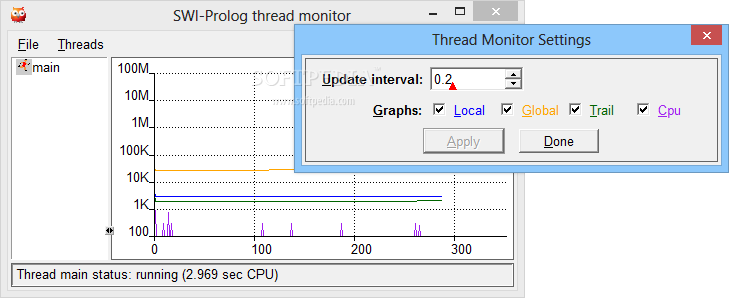Swi Prolog Windows 10
How to create a 3D Terrain with Google Maps and height maps in Photoshop - 3D Map Generator Terrain - Duration: 20:32. Orange Box Ceo 8,313,361 views.
I am developing Prolog code and using SWI-Prolog on two different machines. Both SWI-Prolog installations are on Bash on Ubuntu on Windows 10.
I don't remember the steps I followed to install SWI-Prolog on the first machine, but it runs code requiring library(plunit) without a hitch.Running swipl --version on the console returns
On the second machine, on which I downloaded and made/installed from source, I get an ERROR saying source_sink 'library(plunit)' does not exist. Running swipl --version on the console returns
My understanding was that libraries for SWI-Prolog were release-dependent. Is that not the case? Perhaps the swipl --version values provide some insight? Unfortunately, I am stuck with this specific version of SWI-Prolog for compatibility reasons. So far my attempts to reinstall swipl on the second machine have been fruitless.
Browse other questions tagged prologwindows-10swi-prologwindows-subsystem-for-linuxbash-on-windows or ask your own question.

| Original author(s) | Jan Wielemaker |
|---|---|
| Developer(s) | Jan Wielemaker, Anjo Anjewierden, etc |
| Initial release | 1987; 32 years ago |
| Stable release | |
| Preview release | 8.1.14 / 23 September 2019; 7 days ago |
| Written in | C, Prolog |
| Operating system | Cross-platform |
| Available in | English |
| Type | Logic programming |
| License | Simplified BSD, LGPL prior to version 7.3.33 |
| Website | swi-prolog.org |
SWI-Prolog is a free implementation of the programming languageProlog, commonly used for teaching and semantic web applications.It has a rich set of features, libraries forconstraint logic programming,multithreading,unit testing,GUI,interfacing to Java, ODBC and others,literate programming,a web server,SGML, RDF, RDFS,developer tools (including an IDE with a GUI debugger and GUI profiler), and extensive documentation.
SWI-Prolog runs on Unix, Windows, Macintosh and Linux platforms.
SWI-Prolog has been under continuous development since 1987. Its main author is Jan Wielemaker.
The name SWI is derived from Sociaal-Wetenschappelijke Informatica ('Social Science Informatics'), the former name of the group at the University of Amsterdam, where Wielemaker is employed. The name of this group has changed to HCS (Human-Computer Studies).
Web Framework[edit]
SWI-Prolog installs with a web framework based on definite clause grammars.[1]
Distributed Computing[edit]
Through the Pengines system SWI-Prolog queries may be distributed over several servers and web pages.[2]
XPCE[edit]
XPCE is a platform independentobject oriented[3]GUI toolkit for SWI-Prolog, Lisp and other interactive and dynamically typed languages. Although XPCE was designed to be language-independent, it has gained popularity most with Prolog. The development XPCE graphic toolkit started in 1987, together with SWI-Prolog.

It supports buttons, menus, sliders, tabs and other basic GUI widgets. XPCE is available for all platforms supported by SWI-Prolog.
PceEmacs[edit]
PceEmacs is a SWI-Prolog builtin editor. PceEmacs is an Emacs clone implemented in Prolog (and XPCE). It supports proper indentation, syntax highlighting, full syntax checking by calling the SWI-Prolog parser, warning for singleton variables and finding predicate definitions based on the source-information from the Prolog database.
Interface between Java and Prolog (JPL)[edit]
JPL is a bidirectional interface between Java and Prolog.[4] It requires both SWI-Prolog and Java SDK.[5] It is installed as a part of SWI-Prolog.
Constraint Logic Programming Libraries (CLP)[edit]
Swi Prolog Windows 10 64
Constraint Logic Programming functionality came rather late in the lifetime of SWI-Prolog, because it lacked the basic support[6]. This changed early in 2004 when attributed variables were added to the language. The Leuven CHR library was then the first CLP library to be ported to SWI-Prolog. We mention SWI-Prolog's INCLP(R) library (De Koninck et al. 2006), which provides non-linear constraints over the reals, and was implemented on top of CHR. Later came a port of Christian Holzbaur's CLP(QR) library, and a finite domain CLP(FD) solver. Finally a Boolean CLP(B) solver was added[7].
See also[edit]
Windows 10 Update
References[edit]
Windows 10 Iso
- ^Wielemaker, Jan; Huang, Zhisheng; van der Meij, Lourens (2008). 'SWI-Prolog and the Web'(PDF). Theory and Practice of Logic Programming. 8 (3): 363–392. doi:10.1017/S1471068407003237.
- ^Wielemaker, Jan; Lager, Torbjorn (14 May 2014). 'Pengines: WebLogic Programming Made Easy'. Theory and Practice of Logic Programming. 14 (special issue 4–5): 539–552. arXiv:1405.3953. doi:10.1017/S1471068414000192.
- ^Programming in XPCE/Prolog
- ^http://www.swi-prolog.org/packages/jpl/
- ^http://www.swi-prolog.org/packages/jpl/installation.html
- ^Jan Wielemaker, Tom Schrijvers, Markus Triska, Torbjörn Lager:SWI-Prolog. TPLP 12(1–2): 67–96 (2012)
- ^Markus Triska:The Boolean Constraint Solver of SWI-Prolog (System Description). FLOPS 2016: 45–61